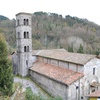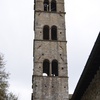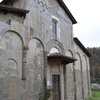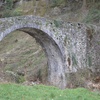Castle of Loppia
The castle of Loppia is located a short distance away from the homonymous church of Santa Maria, on a hill to the north of the place of worship. The surrounding wall, which has an approximately elliptical form, enclosed a space of about 600 square metres and had a considerable thickness, reaching 130 cm. Today only a few fragments of the defensive circuit are preserved: some sections that retain a maximum height of about 2 and a half metres are located in the northwest and southwest portion. The structure dates back approximately to the XI-XII century.
Consecrated in 1058, the Church of Santa Maria di Loppia is one of the masterpieces of the Romanesque style in the valley. The church, with a cross plan in the style of the ancient basilicas, is divided into three naves with wonderful arches.
Historical notes
The first mention of the ”site” of Loppia come to us from a document written in 764 which it cites Barga as a "villa" subordinate to the church of Loppia. Another testimony is from the year 845 when the church was visited by Bishop Ambrose who, considering it of ancient foundation, assigned some artefacts from Cascio to that place of worship.
The first mention of the presence of a castle to defend the church below is in 939, the year in which the fortification was in the hands of Rodilando di Cunimundo, the founder of the powerful Rolandinghi family. The destruction of the castle dates back to 1230, when the armies of Lucca penetrated the valley to quell a rebellion of rural lords. The great importance of the fortification is evident considering that the Rolandinghi, in spite of the fact that the centre of their power had already moved to Barga, continued for centuries to be mentioned in the contracts as "domus de Rolandinghe Loppia». From the description of the structure written in the second half of 800, we know that the fort was equipped with a kind of battifolle (tower-shaped fortification) which was useful in defending the castle church of San Sisto, located outside the defensive circuit between the castle and the church. Unfortunately nothing remains as evidence of the two buildings because both were demolished at the beginning of 1900s and the stones were used to pave the Barga road.












